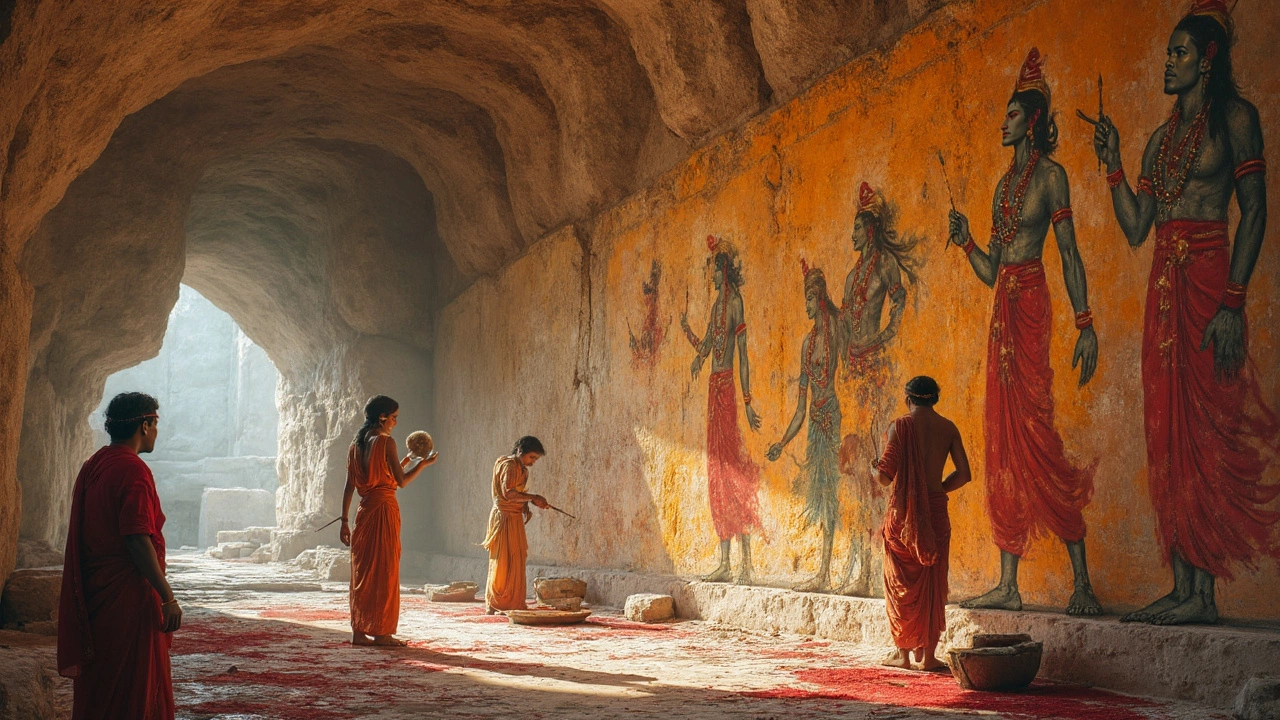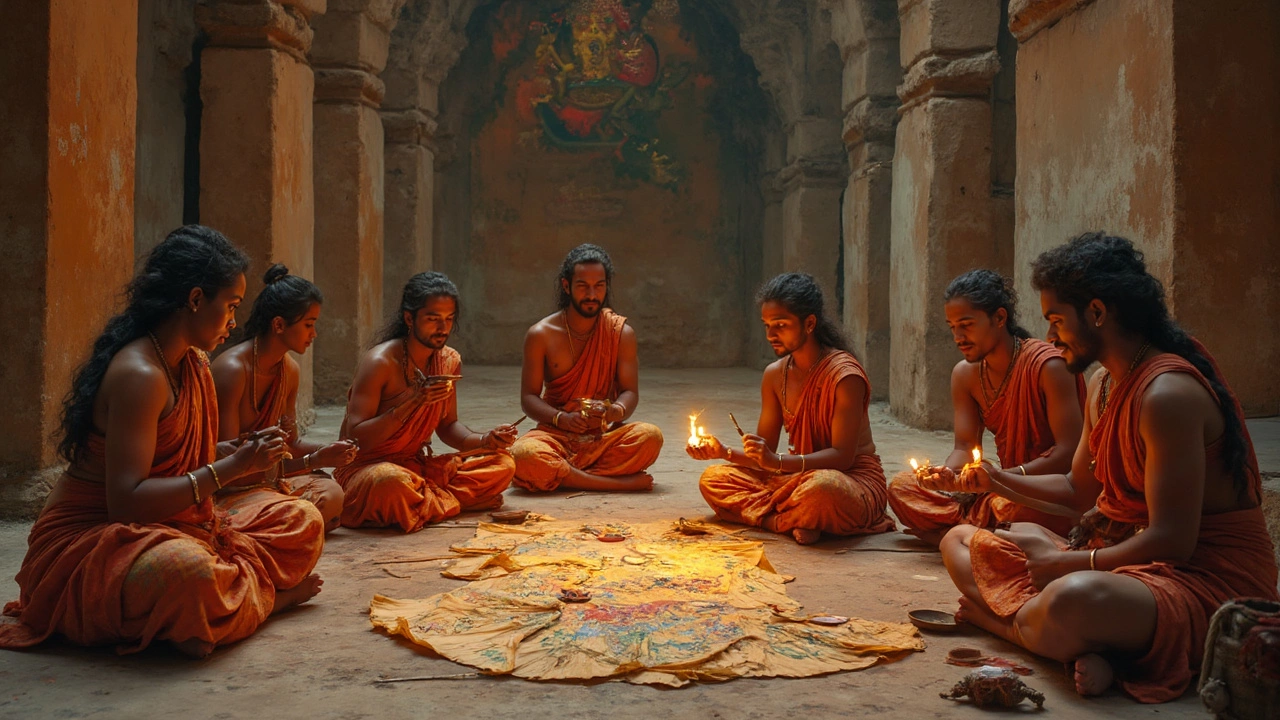No one left a signed painting in ancient India saying, “This is the first ever picture of a Hindu god.” But if you want to peek back in time, the oldest painted god figures aren’t in big museums—they’re hiding on cave walls, ruined pillars, and fraying palm leaves scattered across India.
Here’s the wild thing: most of the first paintings of Hindu gods didn’t even use paintbrushes. Some were scratched into rock, others smeared on with natural dyes. The earliest proof we have comes from places you wouldn’t expect, like the Ajanta Caves, where artists went all-out more than 1,500 years ago. These guys painted scenes full of gods, goddesses, and myth—the kind that still inspire Bollywood movie posters today.
- What Did the First Hindu God Paintings Look Like?
- Where Did Artists Paint Hindu Gods First?
- Who Were These Early Artists?
- How These Ancient Paintings Still Shape Modern Art
What Did the First Hindu God Paintings Look Like?
If you’re picturing modern god photos with shiny crowns and gold halos, forget it. The earliest paintings of Hindu gods were way simpler, almost rough. What shows up in the Ajanta Caves—dating from around the 5th century CE—is nothing like today’s comic book style. Instead, these artists used earthy colors grabbed from nature: red from iron deposits, white from chalk, yellow from clay, and black from burnt wood.
The scenes painted inside the caves? They told stories everyone knew but couldn’t read in a book—picture Krishna sneaking butter or Shiva lost in meditation, but without all the fine details we see now. Limbs sometimes look too long, halos are more like plain yellow discs, and jewelry is suggested by a couple of lines. Symbols were huge here: you could spot Vishnu thanks to his conch, discus, and that four-arm pose, even if his face was less lifelike than a stick figure’s.
Some other places, like the Bagh caves and Sittanavasal, followed the same script. Artists painted gods either on walls or low plaster domes, and they rarely signed their work. The focus was never on making the deities realistic; instead, it was about storytelling—getting the main myth across so even regular folks, who couldn’t read ancient scripts, would know which god was which.
For a long time, these hindu gods appeared in temple murals and early manuscripts in symbolic styles. There was no race for true-to-life images. It was all about recognition: a blue-skinned figure? Definitely Krishna. A destroyer clutching a trident? No doubt—Shiva. Even today, you’ll see most popular depictions still keep these classic tricks to help folks tell their gods apart.
Where Did Artists Paint Hindu Gods First?
The search for the first places artists painted Hindu gods takes you away from city museums and right into old caves and ancient temple walls. The earliest and most famous spot people talk about is the Ajanta Caves in Maharashtra, India. These caves date all the way back to about the 2nd century BCE, but most of the paintings we see now popped up a bit later, between the 4th and 6th centuries CE.
Here, artists covered the walls with massive scenes of stories from Hinduism and Buddhism. You see gods like Vishnu, Shiva, and even some wild demon figures. They didn’t just stop at Ajanta—the trend spread. The Badami Caves in Karnataka, painted around the 6th century CE, served up more images of Hindu gods, showing Shiva as both a dancer and a peaceful yogi.
But here's a surprising fact: these paintings weren't only on caves. People painted gods on temple walls, stone reliefs, and even palm leaf manuscripts. Some of the earliest South Indian temples, like those at Kanchipuram and Thanjavur, have remains of ancient colors used to outline and highlight deities. Private homes sometimes had simple god paintings near doorways for luck, but those rarely survived the weather or time.
If you love data, check out how these locations and dates line up:
| Site | State | Period | Type |
|---|---|---|---|
| Ajanta Caves | Maharashtra | 2nd BCE–6th CE | Wall Murals of Hindu Gods and Buddhist Scenes |
| Badami Caves | Karnataka | 6th CE | Rock-cut Paintings/Reliefs |
| Kanchipuram Temples | Tamil Nadu | 7th–8th CE | Temple Wall Paintings |
| Palm Leaf Manuscripts | Eastern India | 10th CE | Miniature Illustrations |
Most of these places still attract artists and history fans from around the world. If your goal is to see the oldest surviving god paintings with your own eyes, Ajanta Caves remains the top pick. But if you look beyond the famous sites, you’ll spot god figures painted or scratched across India, wherever people reached for stories about the divine.

Who Were These Early Artists?
Most people imagine that famous painters get credit for their work. But when it comes to those who first painted hindu gods, most of their names are lost to history. These early artists worked in teams, not alone. They didn’t leave signatures under their art. Instead, they worked under the direction of kings, monks, and temple builders.
The oldest surviving described artists in India were called “chitrakaras.” Ancient texts like the Vishnudharmottara Purana (written around the 7th century CE) actually gave detailed rules for artists to follow, from the right proportions for a god’s face to what colors mean. Even then, these manuals talk about groups of artisans—painters, carvers, and color makers—working side-by-side.
Here’s something cool: the Ajanta Caves, famous for their stunning Buddhist murals (which also feature Hindu deities), were painted by highly trained professionals. Many were probably part of guilds—sort of like ancient trade unions. These guilds even set up schools that would train the next batch of artists for decades.
Back in those days, artists didn’t just come from fancy royal families. Some were monks, others were skilled craftspeople from regular backgrounds. They trained like apprentices, learning to grind natural dyes, sketch gods onto rock, and layer colors.
Records from the Chola period in southern India (roughly 9th–13th centuries) mention large teams of muralists moving from temple to temple, getting paid in grain, coins, or even a roof over their heads. In places like the Brihadeeswara Temple, you’d find hundreds of names of donors and supervisors—but not the artists themselves.
| Period | Main Region | Who Painted |
|---|---|---|
| Gupta Era (4th–6th century CE) | Central India (Ajanta, Bagh) | Artisan guilds, often tied to Buddhist and Hindu sites |
| Pala Dynasty (8th–12th century CE) | East India (Bihar, Bengal) | Monks, temple artists, manuscript painters |
| Chola Period (9th–13th century CE) | South India (Tamil Nadu) | Muralists, craft guilds, temple workers |
If you think of ancient Indian artists as individual geniuses, it’s more like studio teams today. Each had a role, and the credit usually went to the gods or the king who sponsored the art—not the hands that held the brush.
How These Ancient Paintings Still Shape Modern Art
Modern Indian artists owe a lot to ancient painters. You’ll notice the same bold colors and detailed patterns on temple walls from the 5th century as you do on street murals or even in modern Indian cartoons. The most interesting part? The same poses and hand gestures (mudras) you see in old Ajanta paintings are still used when artists today paint or even animate scenes of Hindu gods.
Painters working thousands of years ago set up rules for how gods look—blue skin for Krishna, ten arms for Durga, funky headgear for Ganesha. Today, whether it’s a festival poster, a comic book, or a movie, pretty much everyone sticks to these ideas. This is why you can spot a character and say, “Aha, that’s Shiva!” even if the style is totally modern.
Those Ajanta murals from around 500 AD were a huge deal—not just for style but for storytelling. Pieces like these taught later artists how to pack big stories into a single frame. Now, graphic novel artists planning a fight scene between gods still use these ancient tricks for drama and detail.
It doesn’t stop there. Designers for Diwali advertisements, wedding cards, and brand logos keep using the color codes and symbols passed down from these old masterpieces. Even tattoo artists in Mumbai borrow bits and pieces from ancient cave art. Basically, if you’re seeing a striking image of a Hindu deity today, you’re looking at a modern echo of ancient creativity.
- Want your art to pop? Take a cue from old temple painters—go for bold outlines and super-bright colors.
- Stuck on how to pose a character? Try the classic hand gestures from Ajanta murals—they still work.
- Need icon ideas for digital design? Ancient Indian art is a free cheat-sheet for shapes, chakras, and patterns that people connect with instantly.
The influence of these early artists is everywhere, proving that hindu gods in ancient art aren’t just a history lesson—they’re still shaping what we see around us every day.
